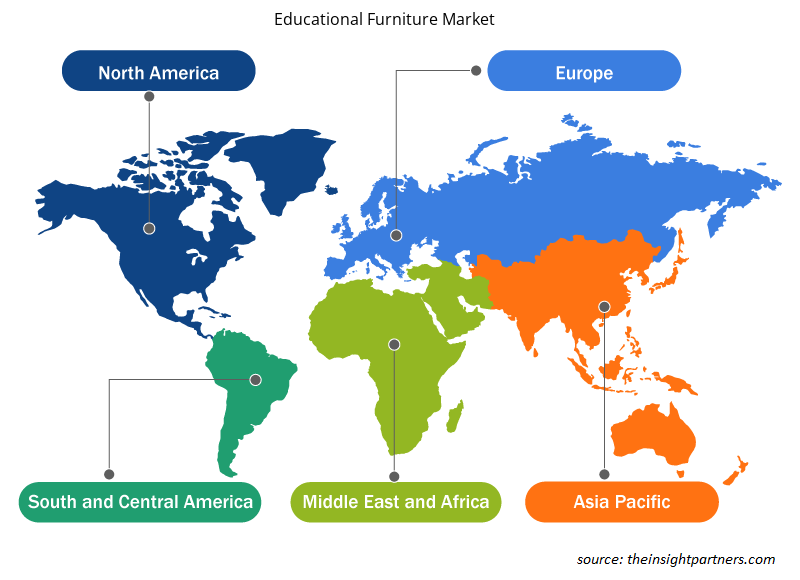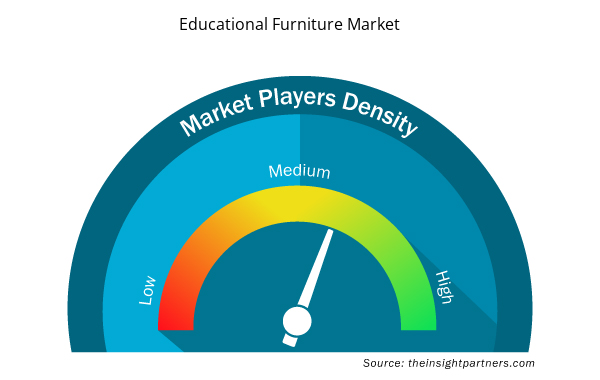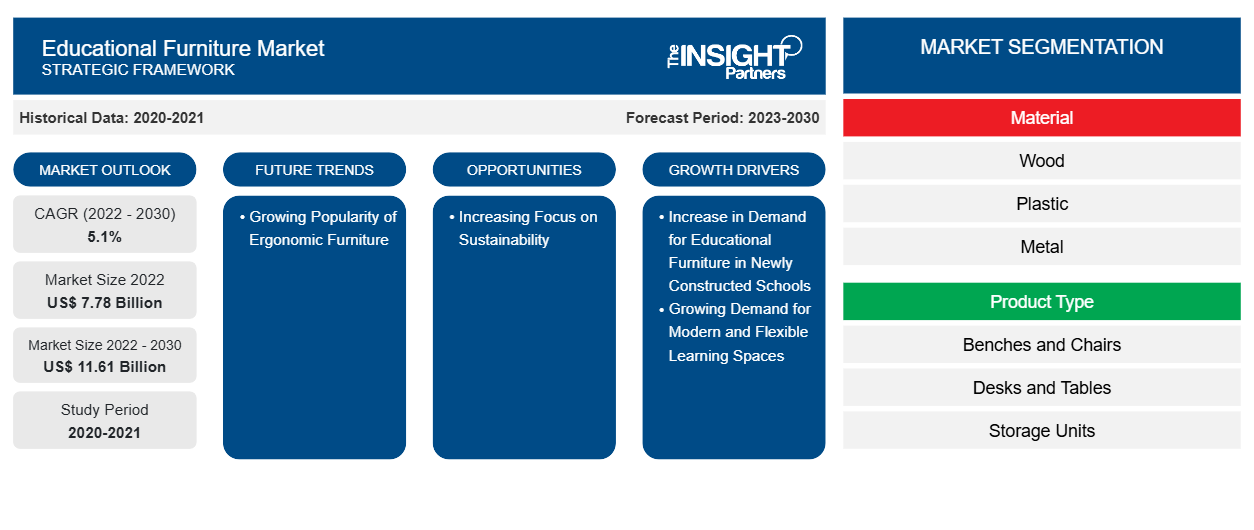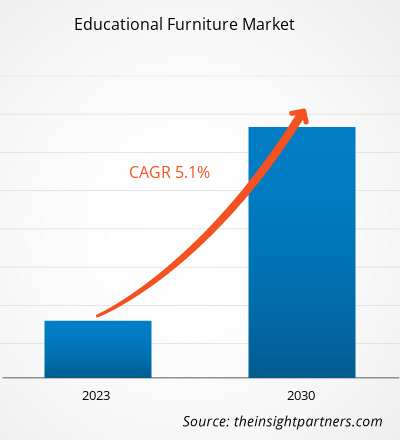[研究报告] 教育家具市场规模预计将从 2022 年的 77.8345 亿美元增长到 2030 年的 116.1164 亿美元;预计 2022 年至 2030 年市场复合年增长率为 5.1%。
市场洞察和分析师观点:
教育家具包括书桌、椅子、白板、橱柜、储物柜和储物柜。为了确保儿童的正确姿势,对符合人体工程学的家具设计的需求不断增长,这是推动小学对现代教育家具需求的关键因素之一。微型学校的兴起趋势,尤其是在疫情之后,推动了对灵活教育家具的需求。微型学校由于班级规模较小,提供个性化的学习环境。这些学校需要灵活的家具,如圆桌、凳子、软座椅和可调节的课桌,以适应个人工作、小组项目和促进轻松学习的互动小组活动。此外,对美学的日益关注推动了对时尚而耐用的家具的需求,这些家具创造了舒适的学习空间,让学生集中注意力。这些因素极大地推动了教育家具市场的增长。
增长动力和挑战:
学校和大学努力在运营过程中更加关注环境,因此对可持续教育家具的需求正在上升。随着教育工作者鼓励学生养成支持环保行为的价值观,绿色教室和全校范围的“绿色环保”倡议正在不断增长。可持续的存储产品、椅子和书桌在世界各地的教室中广受欢迎。这些家具产品采用环保材料制造,如聚丙烯、可再生木材或钢材,符合强制批准的排放标准;此外,它们的设计旨在保持室内空气质量。
在家具制造中使用可持续材料还可以让制造商回收产品废料,从而防止废物堆积到垃圾填埋场。例如,Paragon Furniture Inc. 使用回收或再生纤维来制造其木制品。各国政府都在鼓励企业推出促进学校可持续建设的产品。同样,美国绿色建筑委员会的能源与环境设计先锋 (LEED) 绿色建筑评级系统鼓励建造可持续的高性能设施,并在学校和其他教育设施中采用可持续家具。此类促进可持续基础设施的举措数量增加,可能会为未来几年教育家具市场的增长创造丰厚的机会。
定制此报告以满足您的需求
您可以免费定制任何报告,包括本报告的部分内容、国家级分析、Excel 数据包,以及为初创企业和大学提供优惠和折扣
- 获取此报告的关键市场趋势。这个免费样品将包括数据分析,从市场趋势到估计和预测。
报告细分和范围:
“全球教育家具市场”根据材料、产品类型、最终用途和地理位置进行细分。根据材料,教育家具市场分为木材、塑料、金属和其他。根据产品类型,市场分为长凳和椅子、书桌和桌子、储物柜和其他。就最终用途而言,市场分为机构和住宅。机构部分进一步细分为小学、中学和高等教育。从地理上讲,教育家具市场分为北美(美国、加拿大和墨西哥)、欧洲(德国、法国、意大利、英国、俄罗斯和欧洲其他地区)、亚太地区(澳大利亚、中国、日本、印度、韩国和亚太其他地区)、中东和非洲(南非、沙特阿拉伯、阿联酋和中东和非洲其他地区)以及南美洲和中美洲(巴西、阿根廷和南美洲和中美洲其他地区)
节段分析
根据材料,教育家具市场分为木材、塑料、金属和其他。2021 年,木材占据了最大的市场份额。与其他材料相比,木制家具具有耐用和低维护的特性,是全球最受欢迎的家具之一。此外,与塑料或其他人造材料相比,木制家具是最环保、最可持续的解决方案之一。由于消费者对木材的需求很高,木材通常是家具生产最受欢迎的材料。
按最终用途划分,机构部门在 2022 年占据了最大份额。教育行业的数字化转型推动了对满足数字学习需求的家具的需求。学院和大学越来越多地投资于可容纳笔记本电脑、平板电脑和数字教科书的家具。这些机构还在图书馆、自助餐厅、实验室和会议室等高能见度区域投资美观的家具,以吸引学生和教师并改善学习环境。由于全球发达国家和发展中国家小学和高等教育的重要性日益提高,入读学院、大学和学校的学生人数随着时间的推移而增加。根据美国国家教育统计中心的数据,2021 年,美国约有 1900 万学生就读于学院和大学。随着学生入学人数的增加,对现代、符合人体工程学设计的教育家具的需求也随之增加。这一因素极大地推动了教育家具市场的增长。
区域分析:
根据地理位置,教育家具市场分为五个主要区域:北美、欧洲、亚太、南美和中美以及中东和非洲。全球教育家具市场以北美为主,2022 年为 34.9399 亿美元。欧洲是第二大贡献者,约占全球市场的 24%。此外,预计亚太地区在预测期内将以 5-6% 的复合年增长率大幅增长。美国是区域市场的主要贡献者,其次是加拿大和墨西哥。北美的教育机构正在升级现有资源并采购创新家具。有效的制造和贸易政策也促进了教育家具市场的增长。此外,符合人体工程学设计的学校家具可预防儿童健康问题,尤其是因姿势不正确而引起的健康问题,在该地区越来越受欢迎。美国是主要的教育家具制造商,包括 Fleetwood Furniture、Herman Miller Inc 和 Steelcase Inc。此外,Simplova、Institutional Furniture Ltd、RJH Solutions 和 CDI Spaces 也是在加拿大运营的教育家具制造商和供应商之一。根据美国土木工程师学会发布的 2021 年基础设施报告卡,美国有约 84,000 所公立学校和约 100,000 栋建筑,预计到 2026 年入学人数将达到 5680 万。因此,预计在预测期内,学校数量的增加、对现代和人体工程学家具的倾向以及教育家具制造商的存在将推动北美教育家具市场的发展。
行业发展和未来机遇:
以下列出了教育家具市场主要参与者采取的各种举措:
- 2022 年,AFC Furniture Solutions 收购了 Wipro Enterprises,该公司设计并拥有 Xbench、Vibrant 和 Livo 等品牌。
- 2023 年,Smith System 及其母公司 Steelcase 宣布指定六家新的首要经销商合作伙伴。
教育家具市场区域洞察
Insight Partners 的分析师已详细解释了预测期内影响教育家具市场的区域趋势和因素。本节还讨论了北美、欧洲、亚太地区、中东和非洲以及南美和中美洲的教育家具市场细分和地理位置。

- 获取教育家具市场的区域特定数据
教育家具市场报告范围
| 报告属性 | 细节 |
|---|---|
| 2022 年市场规模 | 77.8亿美元 |
| 2030 年市场规模 | 116.1亿美元 |
| 全球复合年增长率(2022 - 2030 年) | 5.1% |
| 史料 | 2020-2021 |
| 预测期 | 2023-2030 |
| 涵盖的领域 | 按材质
|
| 覆盖地区和国家 | 北美
|
| 市场领导者和主要公司简介 |
|
教育家具市场参与者密度:了解其对业务动态的影响
教育家具市场正在快速增长,这得益于消费者偏好的不断变化、技术进步以及对产品优势的认识不断提高等因素导致的终端用户需求不断增加。随着需求的增加,企业正在扩大其产品范围,进行创新以满足消费者的需求,并利用新兴趋势,从而进一步推动市场增长。
市场参与者密度是指在特定市场或行业内运营的企业或公司的分布情况。它表明在给定市场空间中,相对于其规模或总市场价值,有多少竞争对手(市场参与者)存在。
在教育家具市场运营的主要公司有:
- AFC 家具解决方案私人有限公司
- 弗利特伍德集团
- 学者工艺产品公司
- 史密斯系统制造公司
- 诺尔公司
免责声明:上面列出的公司没有按照任何特定顺序排列。

- 了解教育家具市场主要参与者概况
COVID-19 影响:
在新冠疫情初期,封锁限制措施的实施和生产单位的关闭导致生产短缺,造成供需缺口。各种小型和大型教育家具制造商的盈利能力受到严重阻碍。然而,教育机构和学校通过在线课程进行远程工作,这导致对家庭桌椅等家具的需求激增。由于学校和大学的远程工作和在线辅导的增加,人们对舒适的家庭座椅的需求不断增加,对教育家具产品的需求也随之增加。
2021 年,随着各国政府宣布放松先前实施的限制,各经济体恢复运营,提振了全球市场。制造商被允许满负荷运营,这有助于他们克服供需缺口和其他影响。由于到 2021 年,许多国家的众多公民都已完全接种疫苗,教育家具制造商专注于增加产量以重振业务。这对教育家具市场的增长产生了积极影响。
竞争格局和重点公司:
全球教育家具市场排名前十的公司分别是 AFC Furniture Solutions Pvt Ltd、Fleetwood Group Inc、Scholar Craft Products Inc、Smith Systems Manufacturing Co、Knoll Inc、Haworth Inc、Vitra International AG、Virco Manufacturing Corp、Office Line Srl 和 Creaciones Falcon SLU。这些公司专注于开发具有人体工程学设计的创新家具,以满足消费者的需求。
- 历史分析(2 年)、基准年、预测(7 年)及复合年增长率
- PEST 和 SWOT 分析
- 市场规模价值/数量 - 全球、区域、国家
- 行业和竞争格局
- Excel 数据集


- GNSS Chip Market
- Small Molecule Drug Discovery Market
- Thermal Energy Storage Market
- Intraoperative Neuromonitoring Market
- Adaptive Traffic Control System Market
- Piling Machines Market
- Dealer Management System Market
- Adaptive Traffic Control System Market
- Europe Industrial Chillers Market
- Portable Power Station Market

Report Coverage
Revenue forecast, Company Analysis, Industry landscape, Growth factors, and Trends

Segment Covered
This text is related
to segments covered.

Regional Scope
North America, Europe, Asia Pacific, Middle East & Africa, South & Central America

Country Scope
This text is related
to country scope.
常见问题
Increasing focus on sustainable furniture is expected to provide lucrative growth opportunities to the global educational furniture market during the forecast period.
Based on end use, the educational furniture market for institutional segment is the fastest-growing segment. The growth is attributed to the increasing adoption of education in rural and urban areas, growing school management's inclination toward adopting modern furniture, and the rising school enrollment rates. The demand for educational furniture for institutional use is expected to grow during the forecast period.
The major players operating in the global educational furniture market are Fleetwood Group Inc, Smith Systems Manufacturing Co, Haworth Inc, Office Line Srl, and Virco Manufacturing Corp, among others.
Based on the material, the wood segment accounted for the largest revenue share. Wood-based furniture is popular across the world due to its durability and elegant look compared to plastic furniture. Wood is an excellent material for designing and creating exclusive furniture widely used in educational institutes. These factors are driving its demand, hence surging the market growth.
Asia Pacific market dominated the educational furniture market and continue to be the largest segment by 2028. The largest share of Asia Pacific can be attributed to its increased focus on education across urban and rural areas, and the implementation of mandatory primary education schemes by governments result in the construction of schools and educational institutions across this region.
The increase in demand for educational furniture in newly constructed schools, and growing demand for modern and flexible learning spaces, are some of the key driving factors for the educational furniture market.
Trends and growth analysis reports related to Consumer Goods : READ MORE..
The List of Companies - Educational Furniture Market
- AFC Furniture Solutions Pvt Ltd
- Fleetwood Group Inc
- Scholar Craft Products Inc
- Smith Systems Manufacturing Co
- Knoll Inc
- Haworth Inc
- Vitra International AG
- Virco Manufacturing Corp
- Office Line Srl
- Creaciones Falcon SLU
The Insight Partners performs research in 4 major stages: Data Collection & Secondary Research, Primary Research, Data Analysis and Data Triangulation & Final Review.
- Data Collection and Secondary Research:
As a market research and consulting firm operating from a decade, we have published and advised several client across the globe. First step for any study will start with an assessment of currently available data and insights from existing reports. Further, historical and current market information is collected from Investor Presentations, Annual Reports, SEC Filings, etc., and other information related to company’s performance and market positioning are gathered from Paid Databases (Factiva, Hoovers, and Reuters) and various other publications available in public domain.
Several associations trade associates, technical forums, institutes, societies and organization are accessed to gain technical as well as market related insights through their publications such as research papers, blogs and press releases related to the studies are referred to get cues about the market. Further, white papers, journals, magazines, and other news articles published in last 3 years are scrutinized and analyzed to understand the current market trends.
- Primary Research:
The primarily interview analysis comprise of data obtained from industry participants interview and answers to survey questions gathered by in-house primary team.
For primary research, interviews are conducted with industry experts/CEOs/Marketing Managers/VPs/Subject Matter Experts from both demand and supply side to get a 360-degree view of the market. The primary team conducts several interviews based on the complexity of the markets to understand the various market trends and dynamics which makes research more credible and precise.
A typical research interview fulfils the following functions:
- Provides first-hand information on the market size, market trends, growth trends, competitive landscape, and outlook
- Validates and strengthens in-house secondary research findings
- Develops the analysis team’s expertise and market understanding
Primary research involves email interactions and telephone interviews for each market, category, segment, and sub-segment across geographies. The participants who typically take part in such a process include, but are not limited to:
- Industry participants: VPs, business development managers, market intelligence managers and national sales managers
- Outside experts: Valuation experts, research analysts and key opinion leaders specializing in the electronics and semiconductor industry.
Below is the breakup of our primary respondents by company, designation, and region:

Once we receive the confirmation from primary research sources or primary respondents, we finalize the base year market estimation and forecast the data as per the macroeconomic and microeconomic factors assessed during data collection.
- Data Analysis:
Once data is validated through both secondary as well as primary respondents, we finalize the market estimations by hypothesis formulation and factor analysis at regional and country level.
- Macro-Economic Factor Analysis:
We analyse macroeconomic indicators such the gross domestic product (GDP), increase in the demand for goods and services across industries, technological advancement, regional economic growth, governmental policies, the influence of COVID-19, PEST analysis, and other aspects. This analysis aids in setting benchmarks for various nations/regions and approximating market splits. Additionally, the general trend of the aforementioned components aid in determining the market's development possibilities.
- Country Level Data:
Various factors that are especially aligned to the country are taken into account to determine the market size for a certain area and country, including the presence of vendors, such as headquarters and offices, the country's GDP, demand patterns, and industry growth. To comprehend the market dynamics for the nation, a number of growth variables, inhibitors, application areas, and current market trends are researched. The aforementioned elements aid in determining the country's overall market's growth potential.
- Company Profile:
The “Table of Contents” is formulated by listing and analyzing more than 25 - 30 companies operating in the market ecosystem across geographies. However, we profile only 10 companies as a standard practice in our syndicate reports. These 10 companies comprise leading, emerging, and regional players. Nonetheless, our analysis is not restricted to the 10 listed companies, we also analyze other companies present in the market to develop a holistic view and understand the prevailing trends. The “Company Profiles” section in the report covers key facts, business description, products & services, financial information, SWOT analysis, and key developments. The financial information presented is extracted from the annual reports and official documents of the publicly listed companies. Upon collecting the information for the sections of respective companies, we verify them via various primary sources and then compile the data in respective company profiles. The company level information helps us in deriving the base number as well as in forecasting the market size.
- Developing Base Number:
Aggregation of sales statistics (2020-2022) and macro-economic factor, and other secondary and primary research insights are utilized to arrive at base number and related market shares for 2022. The data gaps are identified in this step and relevant market data is analyzed, collected from paid primary interviews or databases. On finalizing the base year market size, forecasts are developed on the basis of macro-economic, industry and market growth factors and company level analysis.
- Data Triangulation and Final Review:
The market findings and base year market size calculations are validated from supply as well as demand side. Demand side validations are based on macro-economic factor analysis and benchmarks for respective regions and countries. In case of supply side validations, revenues of major companies are estimated (in case not available) based on industry benchmark, approximate number of employees, product portfolio, and primary interviews revenues are gathered. Further revenue from target product/service segment is assessed to avoid overshooting of market statistics. In case of heavy deviations between supply and demand side values, all thes steps are repeated to achieve synchronization.
We follow an iterative model, wherein we share our research findings with Subject Matter Experts (SME’s) and Key Opinion Leaders (KOLs) until consensus view of the market is not formulated – this model negates any drastic deviation in the opinions of experts. Only validated and universally acceptable research findings are quoted in our reports.
We have important check points that we use to validate our research findings – which we call – data triangulation, where we validate the information, we generate from secondary sources with primary interviews and then we re-validate with our internal data bases and Subject matter experts. This comprehensive model enables us to deliver high quality, reliable data in shortest possible time.


 获取此报告的免费样本
获取此报告的免费样本